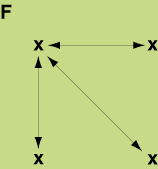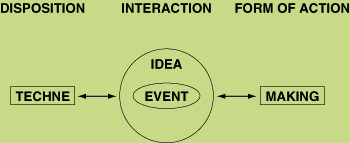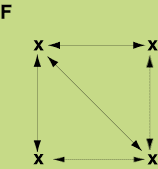© Janet Masters 1995
This article may be cited as:
Masters, J. (1995) 'The History of Action Research' in I. Hughes (ed) Action Research Electronic Reader, The University of Sydney, on-line http://www.behs.cchs.usyd.edu.au/arow/Reader/rmasters.htm (download date 00.00.0000)
The origins of action research are unclear within the literature. Authors such as Kemmis and McTaggert (1988), Zuber-Skerrit (1992), Holter and Schwartz-Barcott (1993) state that action research originated with Kurt Lewin, an American psychologist. McKernan (1988 as cited in McKernan 1991) states that action research as a method of inquiry has evolved over the last century and careful study of the literature shows "clearly and convincingly that action research is a root derivative of the scientific method' reaching back to the Science in Education movement of the late nineteenth century." (McKernan 1991:8)
McKernan (1991:8) also states that there is evidence of the use of action research by a number of social reformists prior to Lewin, such as Collier in 1945, Lippitt and Radke in 1946 and Corey in 1953. McTaggert (1992:2) cites work by Gstettner and Altricher which has a physician named Moreno using group participation in 1913 in a community development initiative with prostitutes in Vienna. Freideres (1992:3-4) asserts that the concept of participatory research emerged in the 1970s from development work in low income countries and mentions names such as Fals-Borda and Freideres.
Despite the clouded origins of action research, Kurt Lewin, in the mid 1940s constructed a theory of action research, which described action research as "proceeding in a spiral of steps, each of which is composed of planning, action and the evaluation of the result of action" (Kemmis and McTaggert 1990:8). Lewin argued that in order to "understand and change certain social practices, social scientists have to include practitioners from the real social world in all phases of inquiry" (McKernan 1991:10). This construction of action research theory by Lewin made action research a method of acceptable inquiry. (McKernan 1991:9)
Movements that have had historical and philosophical influences on action Research are:
Three of the many definitions for action research are: a "systemic inquiry that is collective, collaborative, self-reflective, critical and undertaken by participants in the inquiry" (McCutcheon and Jung 1990:148). "a form of collective self-reflective inquiry undertaken by participants in social situations in order to improve the rationality and justice of their own social or educational practices, as well as their understanding of these practices and the situations in which these practices are carried out" (Kemmis and McTaggert 1990:5). "action research aims to contribute both to the practical concerns of people in an immediate problematic situation and to the goals of social science by joint collaboration within a mutually acceptable ethical framework" (Rapoport 1970:499 as cited in McKernan 1991:4).
Within all these definitions there are four basic themes: empowerment of participants; collaboration through participation; acquisition of knowledge; and social change. The process that the researcher goes through to achieve these themes is a spiral of action research cycles consisting of four major phrases: planning, acting, observing and reflecting (Zuber-Skerrit 1991:2).
Grundy and Kemmis (1981 as cited in Grundy 1988) state that there are three minimal requirements for action research. "These requirements incorporate the goals of improvement and involvement which characterise any action research project. The conditions which are set out there as individually necessary and jointly sufficient for action research to exist are:
Grundy (1988:353) discusses three modes of action research: technical, practical, and emancipatory. Holter and Schwartz-Barcott (1993:301) also discuss three types of action research, that of a technical collaborative approach, a mutual collaborative approach and an enhancement approach. McKernan (1991:16 -27) also list three types of action research:
Type 1: |
the scientific-technical view of problem solving; |
Type 2: |
practical-deliberative action research; and |
Type 3: |
critical-emancipatory action research. |
McCutcheon and Jurg (1990:145-147) discusses three perspectives of action research: a positivist perspective, an interpretivist perspective and a critical science perspective.
Early advocates of action research such as Lippitt and Radke in 1946, Lewin in 1947, Corey in 1953, and Taba and Noel in 1957 put forward a scientific method of problem solving. (McKernan 1991:16) The underlying goal of the researcher in this approach is to test a particular intervention based on a pre-specified theoretical framework, the nature of the collaboration between the researcher and the practitioner is technical and facilitatory. The researcher identifies the problem and a specific intervention, then the practitioner is involved and they agree to facilitate with the implementation of the intervention. (Holter and Schwartz-Barcott 1993:301). The communication flow within this type of research is primarily between the facilitator and the group, so that the ideas may be communicated to the group (Grundy 1982:360).
Technical communication (Grundy 1982:360)

Grundy (1992:355) has developed a model describing technical action research.

(Grundy 1982:355)
Techne being the skill of action research, the idea being how the event will occur, the event is the taking of the idea and the thoughts that the researcher has about the event and making them happen.
A project guided by technical action research will have the following characteristics: the project would be instigated by a particular person or group of people who because of their greater experience or qualifications would be regarded as experts or authority figures. Technical action research promotes more efficient and effective practice. It is product directed but promotes personal participation by practitioners in the process of improvement. "It fosters the disposition characteristic of the artisan within the participating practitioners" (Grundy 1987:154). This approach to action research results in the accumulation of predictive knowledge, the major thrust is on validation and refinement of existing theories and is essentially deductive (Holter et al 1993:301).
In this type of action research project the researcher and the practitioners come together to identify potential problems, their underlying causes and possible interventions (Holter et al 1993:301). The problem is defined after dialogue with the researcher and the practitioner and a mutual understanding is reached. "Practical action research seeks to improve practice through the application of the personal wisdom of the participants" (Grundy, 1982: 357).
The communication flow in this type of action research must be unimpaired between each member of the group and the facilitator. (Grundy 1982:360)

This design of action research allows for a more flexible approach, not available in the positivist paradigm. "Indicative of this flexibility is the frequent use of 'interpretive' as an umbrella term that comfortably accommodates interactive and phenomenological perspectives" (McCutcheon and Jung 1990:146).
McKernan (1991:20) feels that the practical model of action research trades off some measurement and control for human interpretation, interactive communication, deliberation, negotiation and detailed description. "The goal of practical action researchers is understanding practice and solving immediate problems" (McKernan 1991:20). The practitioners involved in the mutual collaborative approach to action research gain a new understanding of their practice, the changes implemented tend to have a more lasting character. However the changes tend to be connected to the individuals directly involved in the change process, and therefore the interventions tend to be short lived when these individuals leave the system or there is an influx of new people (Holter etal 1993:301).
"Practical action research fosters the development of professionalism by emphasising the part played by personal judgement in decisions to act for the good of the client" (Grundy 1987:154). This mode of action research "promotes autonomous, deliberative action - ..praxis" (Grundy 1987:154). Grundy's (1982:357) model for this type of action research is detailed below.

(Grundy 1982:357)
Grundy (1982:356) discusses three types of knowing. The first is techne or knowing-how, the source of skilful action. The second is episteme, the source of scientific action or knowing that. The third type of knowing is phronesis, the knowing-why, the source of moral action which is often called practical judgment. Techne, as occurs in Type 1 action research results in a making action, it is product related. While phronesis results in a doing-action or praxis, and is therefore product centred. The 'Idea' in the interaction is personal, subjective and never fully formed, rather it is constantly being formed and being influenced by the situation (Grundy 1992:357).
Emancipatory action research "promotes emancipatory praxis in the participating practitioners; that is, it promotes a critical consciousness which exhibits itself in political as well as practical action to promote change." (Grundy 1987:154) There are two goals for the researcher using this approach, one is to increase the closeness between the actual problems encountered by practitioners in a specific setting and the theory used to explain and resolve the problem. The second goal, which goes beyond the other two approaches, is to assist practitioners in identifying and making explicit fundamental problems by raising their collective consciousness (Holter et al 1993:302).
Jurgen Habermas, a critical social theorist presents a theoretical model for understanding emancipatory action research. (Habermas 1972 as cited in Grundy 1982) Habermas presents a framework within which social critique may be developed. "It is through the development of critique that the mediation of theory and practice is possible. The development of action-orientated critique has three phrases: theory, enlightenment and action" (Grundy 1982:358).
Emancipated strategic action follows from the disposition of critical intent. (Grundy 1982:358) Critical intent is the disposition which motivates action and interaction at all stages of emancipatory action research and is particularly important in the development of the theoretical perspective which informs and underpins a project (Grundy 1982:358).
Critical intent is not "the intention to be rigorously discriminating only with regard to one's own practice. It has a social consciousness as well in that it is a disposition toward the critical assessment of the extent to which the social milieu impedes the fostering of the good" (Grundy 1982:358). This mode of emancipatory action research does not begin with theory and end with practice, but it is informed by theory and often it is confrontation with the theory that provides the initiative to undertake the practice (Grundy 1982:358). The dynamic relationship between theory and practice in emancipatory action research entails the expansion of both theory and practice during the project.
When a person reflects upon theory in the light of praxis or practical judgment, the form of knowledge that results is personal or tacit knowledge. This tacit knowledge can be acquired through the process of reflection. The interaction of theory and practical judgment through the process of reflection, with the input from critical intent leads to critical theorems (Grundy 1982:359).
The second function which Habermas distinguishes in the mediation of theory and practice is the organisation of the process of enlightenment in which critical theorems are applied and tested in a unique manner by the initiation of processes of reflection carried out within certain groups towards which these processes have been directed. These group processes of reflection will give rise to enlightenment in the form of authentic insights (Habermas 1972 as cited in Grundy 1982:360). The facilitator must not attempt to direct the outcome of the deliberative process by attempting to thrust enlightenment on the participants, but must allow symmetrical communication to occur from which enlightenment will flow (Grundy 1982:360).
The third function which Habermas distinguishes is the organisation of action. The organisation of enlightenment has its focus upon the past while the organisation of action is future orientated (Grundy 1982:361). The form of strategic action resulting from enlightenment is a form of praxis. "Whereas action which resulted from phronesis was also a form of praxis, the development of 'critical theorems' and the process of enlightenment result in the true praxis for it is action which is freed from the dominating constraints of the environment" (Grundy 1982:361).
Grundy (1982:363) has a diagrammatic representation of the above discussion.
Philosophical Base |
Technical Action Research |
Mutual - Collaboration |
Participatory Action |
Natural Sciences |
Historical - hermeneutic |
Critical Sciences |
|
The nature of reality |
Single, measurable, fragmental |
Multiple, constructed, holistic |
Social, economic. Exists with problems of equity and hegemony |
Problem |
Defined in advance |
Defined in situation |
Defined in the situation based on values clarification |
Relationship between the Knower and Known |
Separate |
Interrelated, dialogic |
Interrelated, embedded in society |
Focus of collaboration theory |
Technical validation, refinement, deduction |
Mutual understanding, new theory, inductive |
Mutual emancipation, validation, refinement, new theory, inductive, deductive |
Type of knowledge produced |
Predictive |
Descriptive |
Predictive, descriptive |
Change duration |
Short lived |
Longer lasting, dependent on individuals |
Social change, emancipation |
The nature of understanding |
Events explained in terms of real causes and simultaneous effects |
Events are understood through active mental work, interactions with external context, transactions between one's mental work and external context |
Events are understood in terms of social and economic hindrances to true equity |
The role of value in research |
Value free |
Value bounded |
Related to values of equity |
Purpose of research |
Discovery of laws underlying reality |
Understand what occurs and the meaning people make of phenomena |
Uncover and understand what constrains equity and supports hegemony to free oneself of false consciousness and change practice toward more equity |
It is not in the methodologies that the three modes of action research differ, but rather in the underlying assumptions and world views of the participants that cause the variations in the application of the methodology (Grundy 1982:363).
"The differences in the relationship between the participants and the source and scope of the guiding 'idea' can be traced to a question of power. In technical action research it is the 'idea' which is the source of power for action and since the 'idea' often resides with the facilitator, it is the facilitator who controls power in the project. In practical action research power is shared between a group of equal participants, but the emphasis is upon individual power for action. Power in emancipatory action research resides wholly within the group, not with the facilitator and not with the individuals within the group. It is often the change in power relationships within a group that causes a shift from one mode to another (Grundy 1982:363).
Allen,R., Allen,J., Kraft,C., Certner,B. (1982). The Organisational Unconscious. How to Create the Corporate Culture you Want and Need. Englewood Cliffs New Jersey: Prentice Hall as cited in Hollter,I.M., Schwartz-Barcott,D. (1993). Action Research: What is it? How has it been used and how can it be used in Nursing? Journal of Advanced Nursing 1993,18,298-304
Frideres,J.S., (1992). Participatory Research: An Illusionary Perspective in FrideresJ.S., (ed) (1992). A World of Communities: Participatory Research Perspectives York, Ontario: Caputus University Publications
Grundy,S. and Kemmis,S. (1981). Educational Action Research in Australia: The state of the Art. Paper presented at the Annual Meeting of the Australian Association for Research in Education, Adelaide as cited in Grundy,S. (1988). Three Modes Of Action Research in Kemmis,S. and McTaggert,R. (Ed). (1988). The Action Research Reader (3 ed) Geelong: Deakin University Press.
Grundy, S. (1982). Three Modes Of Action Research. as cited in Kemmis,S. and McTaggert,R. (eds) (1988). The Action Research Reader (3ed). Geelong: Deakin University Press
Grundy,S., (1987) Curriculum: Product or Praxis London: The Falmer Press
HabermasJ., (1974). Theory and Practice. Trans. J Viertal, London: Heinemann as cited in Grundy, S. (1982). Three Modes Of Action Research in Kemmis,S. and McTaggert,R. (eds) (1988). The Action Research Reader (3ed). Geelong: Deakin University Press
Holter, I.M., and Schwartz - Barcott,D. (1993). Action Research: What is it? How has it been used and how can it be used in nursing? Journal of Advanced Nursing 1993:128; 298-304
Kemmis,S., and McTaggert, R., (1990). The Action Research Planner Geelong: Deakin University Press
McCutcheon,G., and Jurg, B., (1990). Alternative Perspectives on Action Research. Theory into Practice Volume 24, Number 3 Summer
McKernan,J., (1988). The Countenance of Curriculum Action Research: Traditional, Collaborative and Critical-Emancipatory Conceptions. Journal of Curriculum and Supervision, 3,(34 Spring:173-200 as cited in McKernan, J., (1991). Curriculum Action Research. A Handbook of Methods and Resources for the Reflective Practitioner London: Kogan Page
McKernan,J., (1991). Curriculum Action Research. A Handbook of Methods and Resources for the Reflective Practitioner London: Kogan Page
McTaggert,R., (1992). Action Research: Issues in Theory and Practice Keynote address to the Methodological Issues in Qualitative Health Research Conference, Friday November 27th, 1992, Geelong: Deakin University
Rapoport,R.N., (1970). Three Dilemmas in Action Research. Human Relations 23:6;499. as cited in McKernanJ., (1991). Curriculum Action Research. A Handbook of Methods and Resources for the Reflective Practitioner London: Kogan Page
Zuber-Skerrit,O., (1992). Improving Learning and Teaching Through Action Learning and Action Research Draft paper for the HERDSA Conference 1992 University of Queensland.
Source: http://www.iopp.ru/pub/21sept06_M2.doc
Web site to visit: http://www.iopp.ru/
Author of the text: indicated on the source document of the above text
If you are the author of the text above and you not agree to share your knowledge for teaching, research, scholarship (for fair use as indicated in the United States copyrigh low) please send us an e-mail and we will remove your text quickly. Fair use is a limitation and exception to the exclusive right granted by copyright law to the author of a creative work. In United States copyright law, fair use is a doctrine that permits limited use of copyrighted material without acquiring permission from the rights holders. Examples of fair use include commentary, search engines, criticism, news reporting, research, teaching, library archiving and scholarship. It provides for the legal, unlicensed citation or incorporation of copyrighted material in another author's work under a four-factor balancing test. (source: http://en.wikipedia.org/wiki/Fair_use)
The information of medicine and health contained in the site are of a general nature and purpose which is purely informative and for this reason may not replace in any case, the council of a doctor or a qualified entity legally to the profession.
The texts are the property of their respective authors and we thank them for giving us the opportunity to share for free to students, teachers and users of the Web their texts will used only for illustrative educational and scientific purposes only.
All the information in our site are given for nonprofit educational purposes